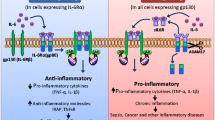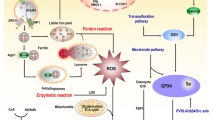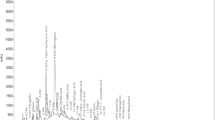Abstract
TRPP2, a Ca2+-permeable non-selective cation channel, has been shown to negatively regulate cell cycle, but the mechanism underlying this regulation is unknown. Tumor necrosis factor α (TNF-α) is a proinflammatory cytokine extensively involved in immune system regulation, cell proliferation and cell survival. However, the effects and mechanisms for the role of TNF-α in laryngeal cancer remain unclear. Here, we demonstrated using western blot analyses and intracellular Ca2+ concentration measurements that TNF-α treatment suppressed both TRPP2 expression and ATP-induced Ca2+ release in a laryngeal cancer cell line (Hep-2). Knockdown of TRPP2 by a specific siRNA significantly decreased ATP-induced Ca2+ release and abolished the effect of TNF-α on the ATP-induced Ca2+ release. TNF-α treatment also enhanced Hep-2 cell proliferation and growth, as determined using cell counting and flow cytometry cell cycle assays. Moreover, TNF-α treatment down-regulated phosphorylated protein kinase R-like endoplasmic reticulum kinase (p-PERK) and phosphorylated eukaryotic translation initiation factor (p-eIF2α) expression levels, without affecting PERK and eIF2α expression levels in Hep-2 cells. We concluded that suppressing TRPP2 expression and TRPP2-mediated Ca2+ signaling may be one mechanism underlying TNF-α-enhanced Hep-2 cell proliferation. These results offer new insights into the mechanisms of TNF-α-mediated laryngeal cancer cell proliferation, and provide evidences showing a potential role of TNF-α in the development of laryngeal cancer.
Similar content being viewed by others
References
Arnould, T., Sellin, L., Benzing, T., Tsiokas, L., Cohen, H.T., Kim, E., and Walz, G. (1999). Cellular activation triggered by the autosomal dominant polycystic kidney disease gene product PKD2. Mol Cell Biol 19, 3423–3434.
Basso, F.G., Pansani, T.N., Turrioni, A.P.S., Soares, D.G., de Souza Costa, C.A., and Hebling, J. (2016). Tumor necrosis factor-α and Interleukin (IL)-1β, IL-6, and IL-8 impair in vitro migration and induce apoptosis of gingival fibroblasts and epithelial cells, delaying wound healing. J Periodontol 87, 990–996.
Baugnon, K.L., and Beitler, J.J. (2013). Pitfalls in the staging of cancer of the laryngeal squamous cell carcinoma. Neuroimaging Clin N Am 23, 81–105.
Brewer, J.W., and Diehl, J.A. (2000). PERK mediates cell-cycle exit during the mammalian unfolded protein response. Proc Natl Acad Sci USA 97, 12625–12630.
Cantero, M.R., Velázquez, I.F., Streets, A.J., Ong, A.C.M., and Cantiello, H.F. (2015). The cAMP signaling pathway and direct protein kinase a phosphorylation regulate polycystin-2 (TRPP2) channel function. J Biol Chem 290, 23888–23896.
Chai, L.P., Wang, Z.F., Liang, W.Y., Chen, L., Chen, D., Wang, A.X., and Zhang, Z.Q. (2013). In vitro and in vivo effect of 5-FC combined gene therapy with TNF-α and CD suicide gene on human laryngeal carcinoma cell line Hep-2. PLoS ONE 8, e61136.
Du, J., Fu, J., Xia, X., and Shen, B. (2016). The functions of TRPP2 in the vascular system. Acta Pharmacol Sin 37, 13–18.
Du, J., and Wilson, P.D. (1995). Abnormal polarization of EGF receptors and autocrine stimulation of cyst epithelial growth in human ADPKD. Am J Physiol 269, C487–C495.
Ferlay, J., Steliarova-Foucher, E., Lortet-Tieulent, J., Rosso, S., Coebergh, J.W.W., Comber, H., Forman, D., and Bray, F. (2013). Cancer incidence and mortality patterns in Europe: estimates for 40 countries in 2012. Eur J Cancer 49, 1374–1403.
Foggensteiner, L., Bevan, A.P., Thomas, R., Coleman, N., Boulter, C., Bradley, J., Ibraghimov-Beskrovnaya, O., Klinger, K., and Sandford, R. (2000). Cellular and subcellular distribution of polycystin-2, the protein product of the PKD2 gene. J Am Soc Nephrol 11, 814–827.
Fujiki, H., Sueoka, E., and Suganuma, M. (2013). Tumor promoters: from chemicals to inflammatory proteins. J Cancer Res Clin Oncol 139, 1603–1614.
Giamarchi, A., Padilla, F., Crest, M., Honore, E., and Delmas, P. (2006). TRPP2: Ca2+-permeable cation channel and more. Cell Mol Biol 52, 105–114.
Grimm, D.H., Karihaloo, A., Cai, Y., Somlo, S., Cantley, L.G., and Caplan, M.J. (2006). Polycystin-2 regulates proliferation and branching morphogenesis in kidney epithelial cells. J Biol Chem 281, 137–144.
Harding, H.P., Novoa, I., Zhang, Y., Zeng, H., Wek, R., Schapira, M., and Ron, D. (2000). Regulated translation initiation controls stress-induced gene expression in mammalian cells. Mol Cell 6, 1099–1108.
Harding, H.P., Zhang, Y., and Ron, D. (1999). Protein translation and folding are coupled by an endoplasmic-reticulum-resident kinase. Nature 397, 271–274.
Hehlgans, T., and Pfeffer, K. (2005). The intriguing biology of the tumour necrosis factor/tumour necrosis factor receptor superfamily: players, rules and the games. Immunology 115, 1–20.
Kip, S.N., Hunter, L.W., Ren, Q., Harris, P.C., Somlo, S., Torres, V.E., Sieck, G.C., and Qian, Q. (2005). [Ca2+]i reduction increases cellular proliferation and apoptosis in vascular smooth muscle cells: relevance to the ADPKD phenotype. Circul Res 96, 873–880.
Koulen, P., Cai, Y., Geng, L., Maeda, Y., Nishimura, S., Witzgall, R., Ehrlich, B.E., and Somlo, S. (2002). Polycystin-2 is an intracellular calcium release channel. Nat Cell Biol 4, 191–197.
Lanoix, J., D’Agati, V., Szabolcs, M., and Trudel, M. (1996). Dysregulation of cellular proliferation and apoptosis mediates human autosomal dominant polycystic kidney disease (ADPKD). Oncogene 13, 1153–1160.
Li, Y., Wright, J.M., Qian, F., Germino, G.G., and Guggino, W.B. (2005). Polycystin 2 interacts with type I inositol 1,4,5-trisphosphate receptor to modulate intracellular Ca2+ signaling. J Biol Chem 280, 41298–41306.
Liang, G., Yang, J.W., Wang, Z., Li, Q., Tang, Y., and Chen, X.Z. (2008). Polycystin-2 down-regulates cell proliferation via promoting PERK-dependent phosphorylation of eIF2α. Hum Mol Genet 17, 3254–3262.
Ma, Y., Huang, D., Yang, F., Tian, M., Wang, Y., Shen, D., Wang, Q., Chen, Q., and Zhang, L. (2016). Long noncoding RNA highly upregulated in liver cancer regulates the tumor necrosis factor-α-induced apoptosis in human vascular endothelial cells. DNA Cell Biol 35, 296–300.
Marciniak, S.J., Garcia-Bonilla, L., Hu, J., Harding, H.P., and Ron, D. (2006). Activation-dependent substrate recruitment by the eukaryotic translation initiation factor 2 kinase PERK. J Cell Biol 172, 201–209.
Mochizuki, T., Wu, G., Hayashi, T., Xenophontos, S.L., Veldhuisen, B., Saris, J.J., Reynolds, D.M., Cai, Y., Gabow, P.A., Pierides, A., Kimberling, W.J., Breuning, M.H., Constantinou Deltas, C., Peters, D.J.M., and Somlo, S. (1996). PKD2, a gene for polycystic kidney disease that encodes an integral membrane protein. Science 272, 1339–1342.
Newby, L.J., Streets, A.J., Zhao, Y., Harris, P.C., Ward, C.J., and Ong, A.C.M. (2002). Identification, characterization, and localization of a novel kidney polycystin-1-polycystin-2 complex. J Biol Chem 277, 20763–20773.
Ron, D. (2002). Translational control in the endoplasmic reticulum stress response. J Clin Invest 110, 1383–1388.
Sammels, E., Devogelaere, B., Mekahli, D., Bultynck, G., Missiaen, L., Parys, J.B., Cai, Y., Somlo, S., and De Smedt, H. (2010). Polycystin-2 activation by inositol 1,4,5-trisphosphate-induced Ca2+ release requires its direct association with the inositol 1,4,5-trisphosphate receptor in a signaling microdomain. J Biol Chem 285, jbc.M109.090662.
Sand, T.E., Thoresen, G.H., Refsnes, M., and Christoffersen, T. (1992). Growth-regulatory effects of glucagon, insulin, and epidermal growth factor in cultured hepatocytes. Digest Dis Sci 37, 84–92.
Sequeira, S.J., Ranganathan, A.C., Adam, A.P., Iglesias, B.V., Farias, E.F., and Aguirre-Ghiso, J.A. (2007). Inhibition of proliferation by PERK regulates mammary acinar morphogenesis and tumor formation. PLoS ONE 2, e615.
Sethi, G., Sung, B., and Aggarwal, B.B. (2008). TNF: a master switch for inflammation to cancer. Front Biosci Volume, 5094.
Shen, B., Zhu, J., Zhang, J., Jiang, F., Wang, Z., Zhang, Y., Li, J., Huang, D., Ke, D., Ma, R., and Du, J. (2013). Attenuated mesangial cell proliferation related to store-operated Ca2+ entry in aged rat: the role of STIM 1 and Orai 1. Age 35, 2193–2202.
Streets, A.J., Needham, A.J., Gill, S.K., and Ong, A.C.M. (2010). Protein kinase D-mediated phosphorylation of polycystin-2 (TRPP2) is essential for its effects on cell growth and calcium channel activity. Mol Biol Cell 21, 3853–3865.
Yoon, W.J., Won, S.J., Ryu, B.R., and Gwag, B.J. (2003). Blockade of ionotropic glutamate receptors produces neuronal apoptosis through the Bax-cytochrome C-caspase pathway: the causative role of Ca2+ deficiency. J Neurochem 85, 525–533.
Zhao, R., Zhou, M., Li, J., Wang, X., Su, K., Hu, J., Ye, Y., Zhu, J., Zhang, G., Wang, K., Du, J., Wang, L., and Shen, B. (2015). Increased TRPP2 expression in vascular smooth muscle cells from high-salt intake hypertensive rats: the crucial role in vascular dysfunction. Mol Nutr Food Res 59, 365–372.
Acknowledgements
This work was supported by the Anhui Provincial Natural Science Foundation (1408085MH157), Supporting Program for Excellent Young Talents in Universities of Anhui Province, Outstanding Young Investigator of Anhui Medical University, National Natural Science Foundation of China (81570403, 81371284), and Scientific Research Grant of Anhui Medical University (2015xkj080).
Author information
Authors and Affiliations
Corresponding authors
Rights and permissions
About this article
Cite this article
Wu, J., Guo, J., Yang, Y. et al. Tumor necrosis factor α accelerates Hep-2 cells proliferation by suppressing TRPP2 expression. Sci. China Life Sci. 60, 1251–1259 (2017). https://doi.org/10.1007/s11427-016-9030-5
Received:
Accepted:
Published:
Issue Date:
DOI: https://doi.org/10.1007/s11427-016-9030-5




